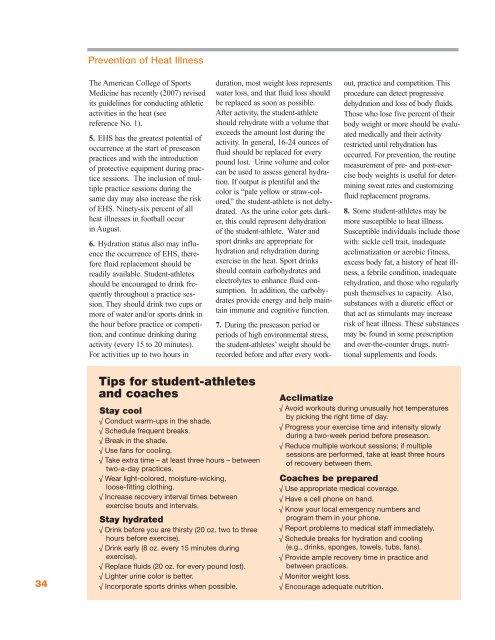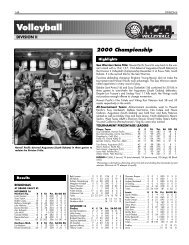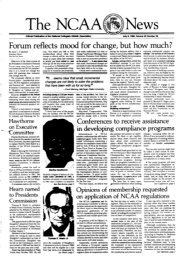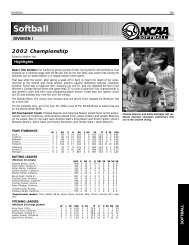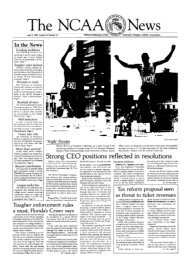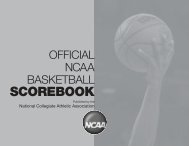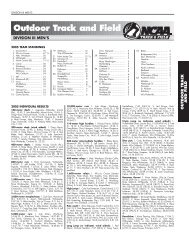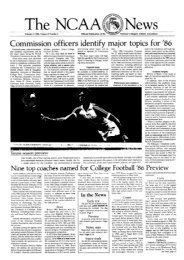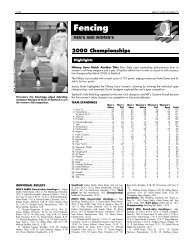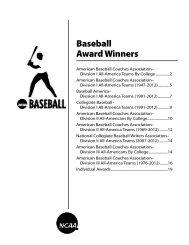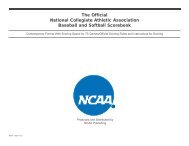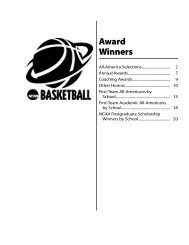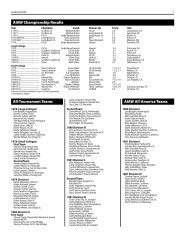Sports Medicine Handbook - NCAA
Sports Medicine Handbook - NCAA
Sports Medicine Handbook - NCAA
Create successful ePaper yourself
Turn your PDF publications into a flip-book with our unique Google optimized e-Paper software.
34<br />
Prevention of Heat Illness<br />
The American College of <strong>Sports</strong><br />
<strong>Medicine</strong> has recently (2007) revised<br />
its guidelines for conducting athletic<br />
activities in the heat (see<br />
reference No. 1).<br />
5. EHS has the greatest potential of<br />
occurrence at the start of preseason<br />
practices and with the introduction<br />
of protective equipment during practice<br />
sessions. The inclusion of multiple<br />
practice sessions during the<br />
same day may also increase the risk<br />
of EHS. Ninety-six percent of all<br />
heat illnesses in football occur<br />
in August.<br />
6. Hydration status also may influence<br />
the occurrence of EHS, therefore<br />
fluid replacement should be<br />
readily available. Student-athletes<br />
should be encouraged to drink frequently<br />
throughout a practice session.<br />
They should drink two cups or<br />
more of water and/or sports drink in<br />
the hour before practice or competition,<br />
and continue drinking during<br />
activity (every 15 to 20 minutes).<br />
For activities up to two hours in<br />
Tips for student-athletes<br />
and coaches<br />
Stay cool<br />
√ Conduct warm-ups in the shade.<br />
√ Schedule frequent breaks.<br />
√ Break in the shade.<br />
√ Use fans for cooling.<br />
√ Take extra time – at least three hours – between<br />
two-a-day practices.<br />
√ Wear light-colored, moisture-wicking,<br />
loose-fitting clothing.<br />
√ Increase recovery interval times between<br />
exercise bouts and intervals.<br />
Stay hydrated<br />
√ Drink before you are thirsty (20 oz. two to three<br />
hours before exercise).<br />
√ Drink early (8 oz. every 15 minutes during<br />
exercise).<br />
√ Replace fluids (20 oz. for every pound lost).<br />
√ Lighter urine color is better.<br />
√ Incorporate sports drinks when possible.<br />
duration, most weight loss represents<br />
water loss, and that fluid loss should<br />
be replaced as soon as possible.<br />
After activity, the student-athlete<br />
should rehydrate with a volume that<br />
exceeds the amount lost during the<br />
activity. In general, 16-24 ounces of<br />
fluid should be replaced for every<br />
pound lost. Urine volume and color<br />
can be used to assess general hydration.<br />
If output is plentiful and the<br />
color is “pale yellow or straw-colored,”<br />
the student-athlete is not dehydrated.<br />
As the urine color gets darker,<br />
this could represent dehydration<br />
of the student-athlete. Water and<br />
sport drinks are appropriate for<br />
hydration and rehydration during<br />
exercise in the heat. Sport drinks<br />
should contain carbohydrates and<br />
electrolytes to enhance fluid consumption.<br />
In addition, the carbohydrates<br />
provide energy and help maintain<br />
immune and cognitive function.<br />
7. During the preseason period or<br />
periods of high environmental stress,<br />
the student-athletes’ weight should be<br />
recorded before and after every work-<br />
out, practice and competition. This<br />
procedure can detect progressive<br />
dehydration and loss of body fluids.<br />
Those who lose five percent of their<br />
body weight or more should be evaluated<br />
medically and their activity<br />
restricted until rehydration has<br />
occurred. For prevention, the routine<br />
measurement of pre- and post-exercise<br />
body weights is useful for determining<br />
sweat rates and customizing<br />
fluid replacement programs.<br />
8. Some student-athletes may be<br />
more susceptible to heat illness.<br />
Susceptible individuals include those<br />
with: sickle cell trait, inadequate<br />
acclimatization or aerobic fitness,<br />
excess body fat, a history of heat illness,<br />
a febrile condition, inadequate<br />
rehydration, and those who regularly<br />
push themselves to capacity. Also,<br />
substances with a diuretic effect or<br />
that act as stimulants may increase<br />
risk of heat illness. These substances<br />
may be found in some prescription<br />
and over-the-counter drugs, nutritional<br />
supplements and foods.<br />
Acclimatize<br />
√ Avoid workouts during unusually hot temperatures<br />
by picking the right time of day.<br />
√ Progress your exercise time and intensity slowly<br />
during a two-week period before preseason.<br />
√ Reduce multiple workout sessions; if multiple<br />
sessions are performed, take at least three hours<br />
of recovery between them.<br />
Coaches be prepared<br />
√ Use appropriate medical coverage.<br />
√ Have a cell phone on hand.<br />
√ Know your local emergency numbers and<br />
program them in your phone.<br />
√ Report problems to medical staff immediately.<br />
√ Schedule breaks for hydration and cooling<br />
(e.g., drinks, sponges, towels, tubs, fans).<br />
√ Provide ample recovery time in practice and<br />
between practices.<br />
√ Monitor weight loss.<br />
√ Encourage adequate nutrition.


